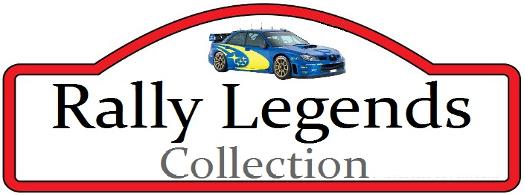
1959 Triumph Herald 948cc coupe
1959 was a notable year for the British motoring public as the Austin Mini, the Ford Anglia 105E and the Triumph Herald were all launched into the very competitive small saloon car market. The first to meet the public was the Triumph Herald.
The Coventry based company Triumph began making bicycles in 1887 and like many of the early cycle manufacturers they moved into motor cars. The earliest Triumphs were mainly conventionally engineered and conservatively styled small and medium-sized saloons. Sporting models were introduced in the early 1930’s but too many models and too much competition bankrupted Triumph in 1939; the company was eventually sold in 1944 to Standard Motor Company Limited. In 1959, the company renamed itself as Standard-Triumph International Limited.
The highly successful 2-seater TR-series sports cars re-established the marques reputation, both at home and abroad, and persuaded Standard-Triumph to badge all future models as simply, “Triumphs”. Triumph flourished as the sporting arm of Standard-Triumph while the Standard name stood alone for the saloon cars and parts manufacturing side of the business.
While Standard-Triumph had been doing rather well with their saloon car range competition from the Morris Minor, Ford Popular and Austin A35 was making inroads into the sales of Standards. The range really needed a lift as the rather dumpy looking Standards didn’t seem to be appealing to customers any more. Standard-Triumph began the process of designing a new car.
The choice of name suggests the car was originally intended for marketing as a “Standard”. Their range had the Ensign, Pennant and Standard itself so "Herald" fits the bill as a Standard car. Triumphs were “TR” plus numerals… not names! Replacing the small Standard saloons with something that could better the competition was going to need something as new and modern as could be managed within a reasonable budget and time frame. The Standard-Triumph board commissioned Italian designer Giovanni Michelotti to style the car, working in conjunction with chief engineer Harry Webster. Michelotti soon had a modern stylish two-door saloon design down on paper. The design combined aspects of American fins and accents with a more recognisably British sports car lines and grill, Italian flair and most importantly, such a large expanse of glass as to give the driver 93% all-round visibility.
With the looks pinned down the mechanics had to be considered. The mechanical parts and construction process choices were a curious mix of old and new. For instance, all round independent suspension (new), was mounted on a solid chassis frame (old). While most cars now used the unitary monocoque form of body Standard-Triumph chose to use a separate chassis right from the start of the design process. This proved to be a clever idea in that every panel, including the sills and the roof were bolted together and bolted to the chassis. This facilitated panel replacement in the event of an accident but more importantly meant that all the different body styles, coupé, saloon convertible, estate and van (the Triumph Courier) models, could be easily produced on the same chassis. Another design feature which critics liked was that the whole front end tilted forward giving unprecedented levels of access to the engine.
The Triumph Herald was officially presented to the motoring press at the Royal Albert Hall on the 22nd of April 1959. Comedian Bob Monkhouse hosted an event at which 1,500 invited guests were wined, dined and entertained before Triumph Herald branded shrouds were removed from the cars in the middle of the hall. There was even a special twist in that a car was built right in front of those present, who were delighted when the car started and demonstrated its impressively small turning circle.
The Public launch was at the Earls Court motor show and the sharp modern styling, light interior, carpeting and heater as standard, all struck a chord with the buyers. But the price tag proved to be a stumbling block, almost £700 (including Purchase Tax); sales took time to build.
The motor from the Standard 10 and Pennant was used to propel the new Herald cars. A 4-cylinder 948cc OHV engine mated to a 4-speed manual gearbox with synchromesh on the top three gears. The rack and pinion steering was light and precise and the tight 25-foot (7.6 m) turning circle was as good as a London Taxi.
The suspension was by double-wishbone with coil springs at the from and "limited" independent at the rear provided by the single transverse leaf-spring bolted to the top of the differential and swing axles. Shock absorption was by telescopic dampers all round.
Instrumentation was sparse, a single large speedometer incorporated the fuel gauge, a temperature gauge was an optional extra. The dash’ was a grey pressed fibreboard, somewhat bland and later models were enhanced by wood veneer.
One quirky item under the dash on the passenger side was a unique parcel tray supplied in the absence of a glove box. Nicknamed the ‘chip basket’ the Sankey grey plastic-coated wire basket was hinged under the dash and held in place by a single metal clip, backed up by plastic straps to stop it falling all the way open and depositing maps, magazines and such all over the passenger and/or floor.
A good range of bright modern colours complimented the body shape and optional extras like twin SU carburettors, front disc brakes, Telaflo shock absorbers, leather seats, a wood veneered dashboard, and later a sunroof, gave the Herald purchaser an opportunity for a thoroughly modern looking car.
While the Herald looked good was easy to drive and had some impressive features it also came with problems. The bolt on body system was great for repair work but the flexible nature of this structure resulted in lots of creaks, groans and thumps. When pushed to the limit the rear suspension gave poor handling at the rear, in its original standard single carburettor form the engine yielded only average performance. 0-60 mph took around anything up to 30 sec’s and top speed was little more than 70mph. Fuel consumption was equally average at 36.4 miles per imperial gallon.
15,153 Herald 948cc coupés were produced between March 1959 and June 1961. During development of the Herald in late 1958 prototype cars were tested on a challenging drive from Cape Town to Tangiers. Incredibly the production cars had only minor changes from these prototypes and the test run story was suitably embellished for PR purposes. Once the coupe hit the markets Standard Triumph were keen to add to the sporty image of Triumph and Heralds took part in many rallies over the years and had successes in the Alpine, Monte Carlo, RAC and Tulip rallies.
It is estimated that there are only around 162 coupes remaining worldwide today and these are especially sought after by enthusiasts and collectors.
Our model is a representation of the car that Ian "Tiny" Lewis & Tony Nash drove to 9th place overall in the 20th Criterium International des Alpes (Alpine Rally) in 1959.
The Alpine rally
No helmets, casual clothing, lap belts and maps. These were the hallmarks of the early years of rallying. The Alpine Rally, or Criterium International de la Montagne - Coupe des Alpes, was the nearest thing to a road race that there was after the Mille Miglia was stopped. First held in 1932 as the Rallye des Alpes Francaises the race was based in Marseille, from 1946 it was renamed the Rallye International des Alpes and run in cooperation with the National Automobile Clubs of several of Europe's leading nations.
Taking in practically every mountain in Europe competitors dashed through the treacherous mountain passes of France, Austria, Germany and Switzerland while sharing the roads with the ordinary public at the same time. The Alpine rally became one of the most prestigious rallies on the calendar, feared and loved, as one of the most gruelling of challenges. Gravel roads saw competitors slide their cars around corners just feet away from sheer drops of hundreds, even thousands, of feet. All that existed to protect competitors from this plunge to their deaths (should their exuberance take them past their fair measure of luck), were inadequate barriers or broken fences; or more often than not, nothing to at all.
The required average speeds for the rally were not high, around 35-40 mph depending on the severity of the stage, but if the competitor was only able to manage 20mph on the way up they needed to average 40mph on the way down, something not recommended for the average driver and still extremely hairy for the skilled competition driver. But it remained popular and in 1953, the Alpine Rally was included as a round of the inaugural European Rally Championship.
The 20th Criterium International des Alpes was held over the 23rd-29th June 1959. Standard-Triumph entered two early production coffee coloured Triumphs Herald coupes in the Alpine Rally, one driven by Dudley Barker and Donnelly carrying #100 and the second car driven by Ian 'Tiny' Lewis and Tony Nash carrying #101. Both the Heralds finished the 2,400 mile rally from Marseilles to Cortina, through the Italian Dolomites, and back to finish in Cannes. The #101 car driven by ‘Tiny’ Lewis finished 9th overall and had no penalty points at all, so they won themselves a highly coveted Coupe des Alpes.
All competitors who completed the rally within the target times earned a Coupe des Alpes (Alpine Cup). For the rare few drivers who managed to do this 3 years running a Coupe d'Or (Gold Cup) was awarded. For those who managed the feat, but not consecutively, a Silver Coupe d'Argent was given. Any driver who could stay within the target times on the tortuous event should be justifiably proud. The Alpine Rally was a greater test of car and driver than any other rally, so much so that in 1958 Autocar magazine carried the lines :-
"without doubt, the Alpine Rally was one of the most formidable motoring events of any type in the international calendar."
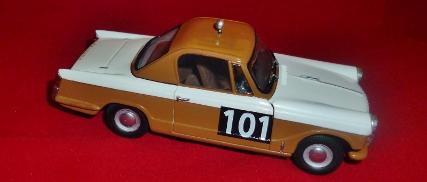



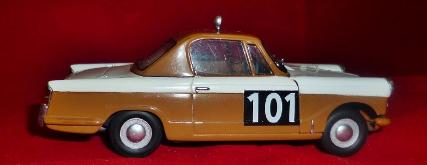
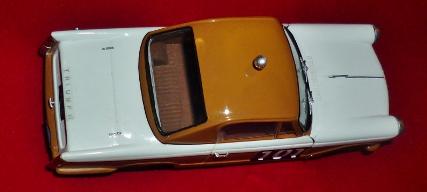

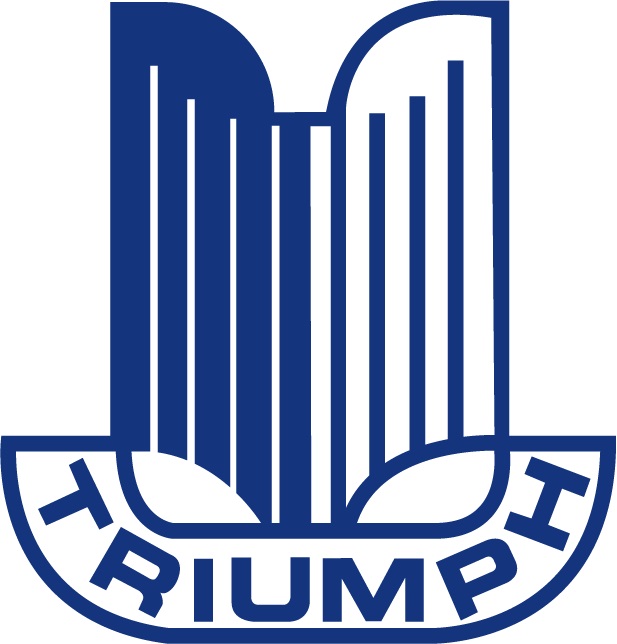


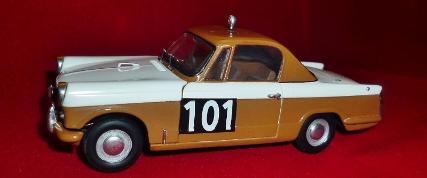


This model was built from Airfix kit #A55201, the 2012 re-issue starter set which included six paints, a brush and a tube of glue. Tube glue is a rarity these days and really not appropriate for those starting the hobby. What is strange is that Airfix released this version after the 2011 set, kit #A55201, which had six paints, two brushes and the precision applicator glue rather than the tube glue. Why? The Herald was also released in the three car set, Airfix # 07900, in 1991. The set included the Triumph TR4, Triumph Herald, Ford Escort and was a very good value for money set. The original kit, #M204C went on sale in 1967 in a plastic bag with a header card. The Plastic is the same in all the kits, as is the actual pictures and illustrations. The changes are the addition of endless language warnings and guidance notices and a small decal sheet.
A lovely kit for 1967, loads of detail and generally a very good representation of the Herald. There is evidence of the age of the moulds as flash, slight misalignment and ejector pin marks are found all over the model. However, most of these are well hidden or easily dealt with and, overall, even for the age of the moulds, this is still a great kit.
The difficulty with these older kits is the fit of the clear parts which need some help to fit nicely and look good. Deluxe Material’s "Glue’n’Glaze" proves very helpful. The lack of clear headlamp lenses is something of a let-down in this day and age, it wouldn’t have been that hard to put some lenses in or add the parts to the clear sprue as well as the grey plastic sprue.
Ian added a large amount of detail to the model, from engine wiring and plumbing to interior door cards and window winders. Even the bonnet handle had to be scratch built. The conversion of the saloon to the coupe required not only the changes to the roof line but also the rear seat and rear interior area. To do the rally coupe also meant additional lights in the front grill and an internal hand operable spot light on the roof, bits from the spares box and a little scratch building took care of these items.
RETURN TO :-
